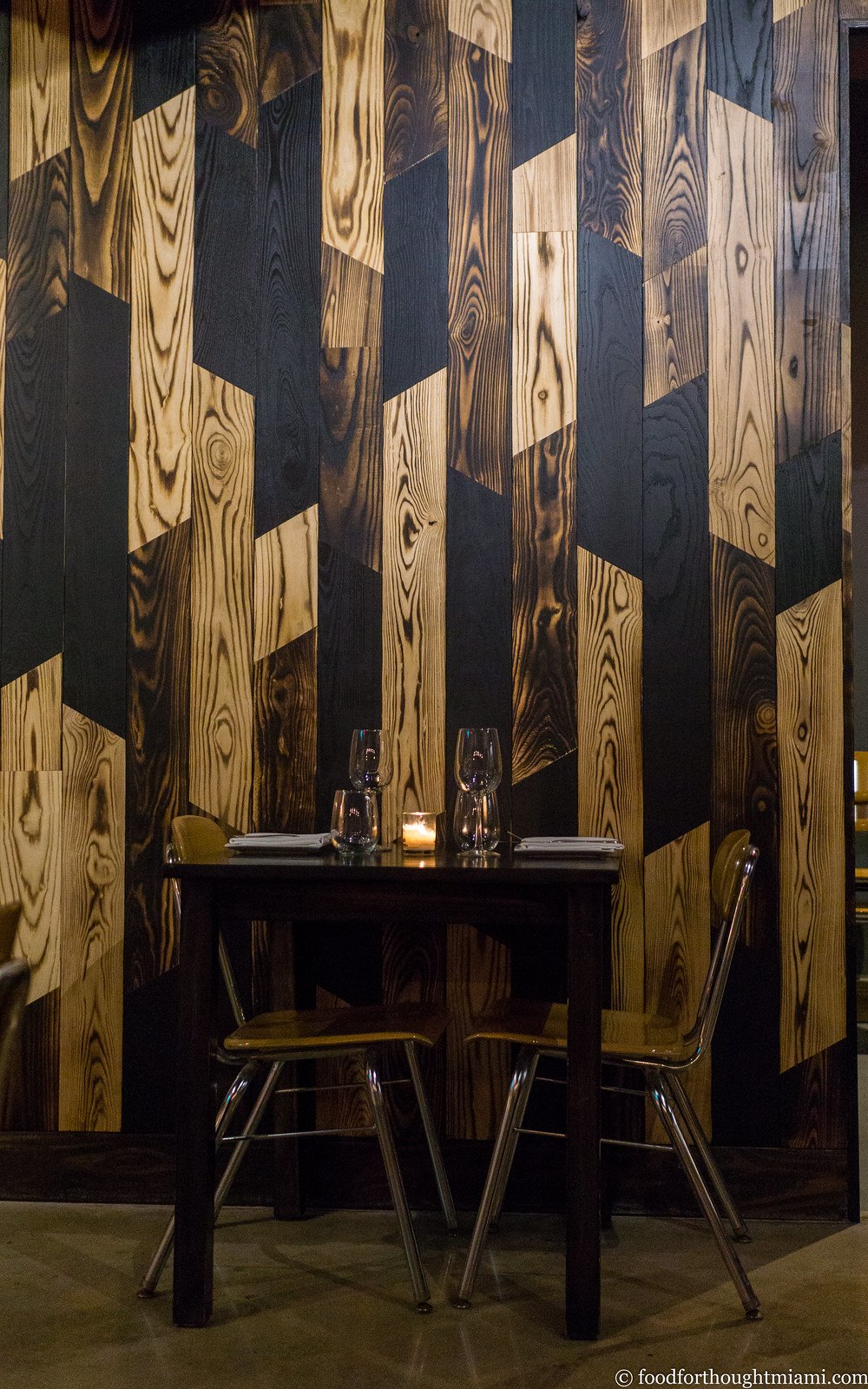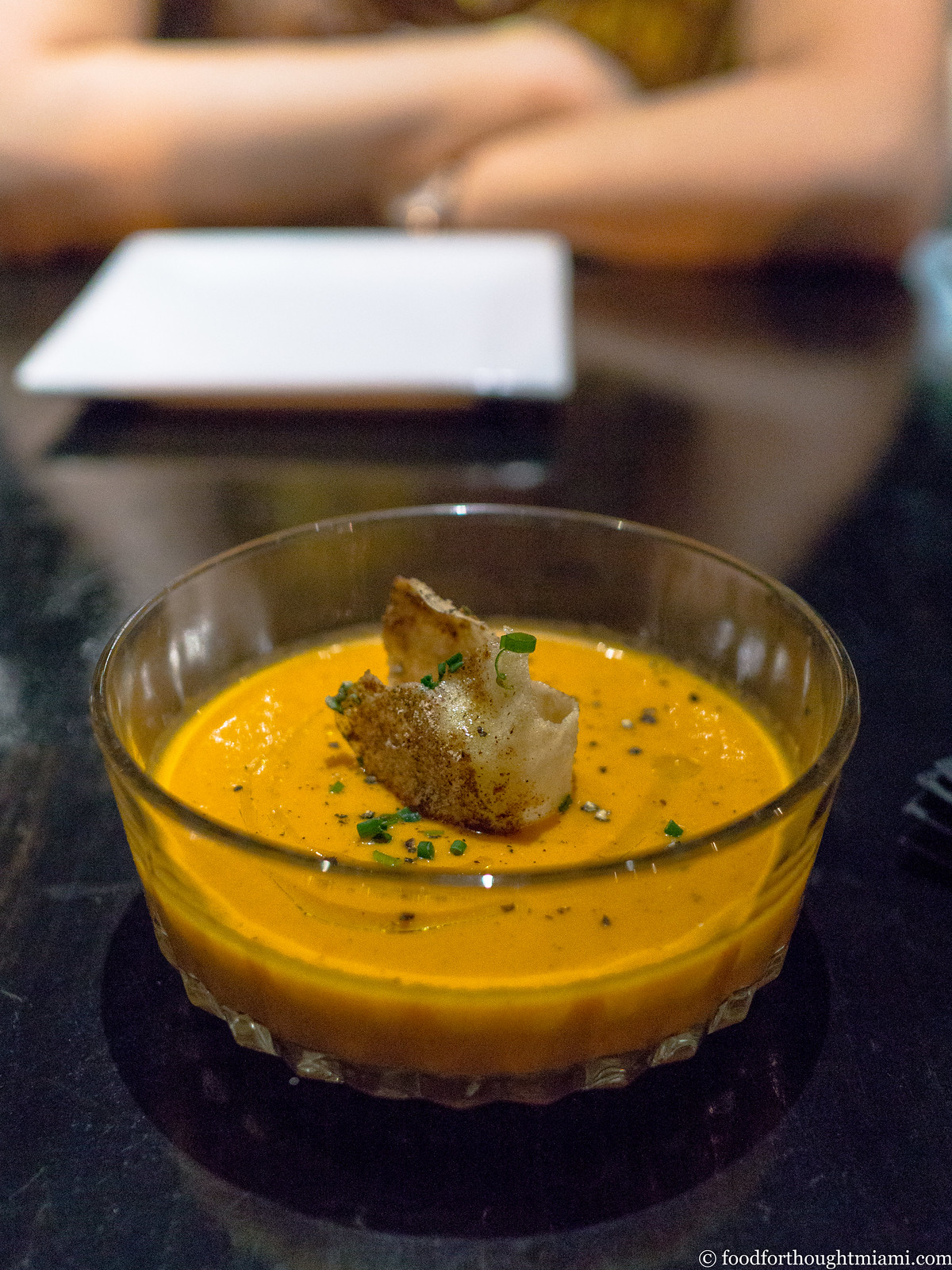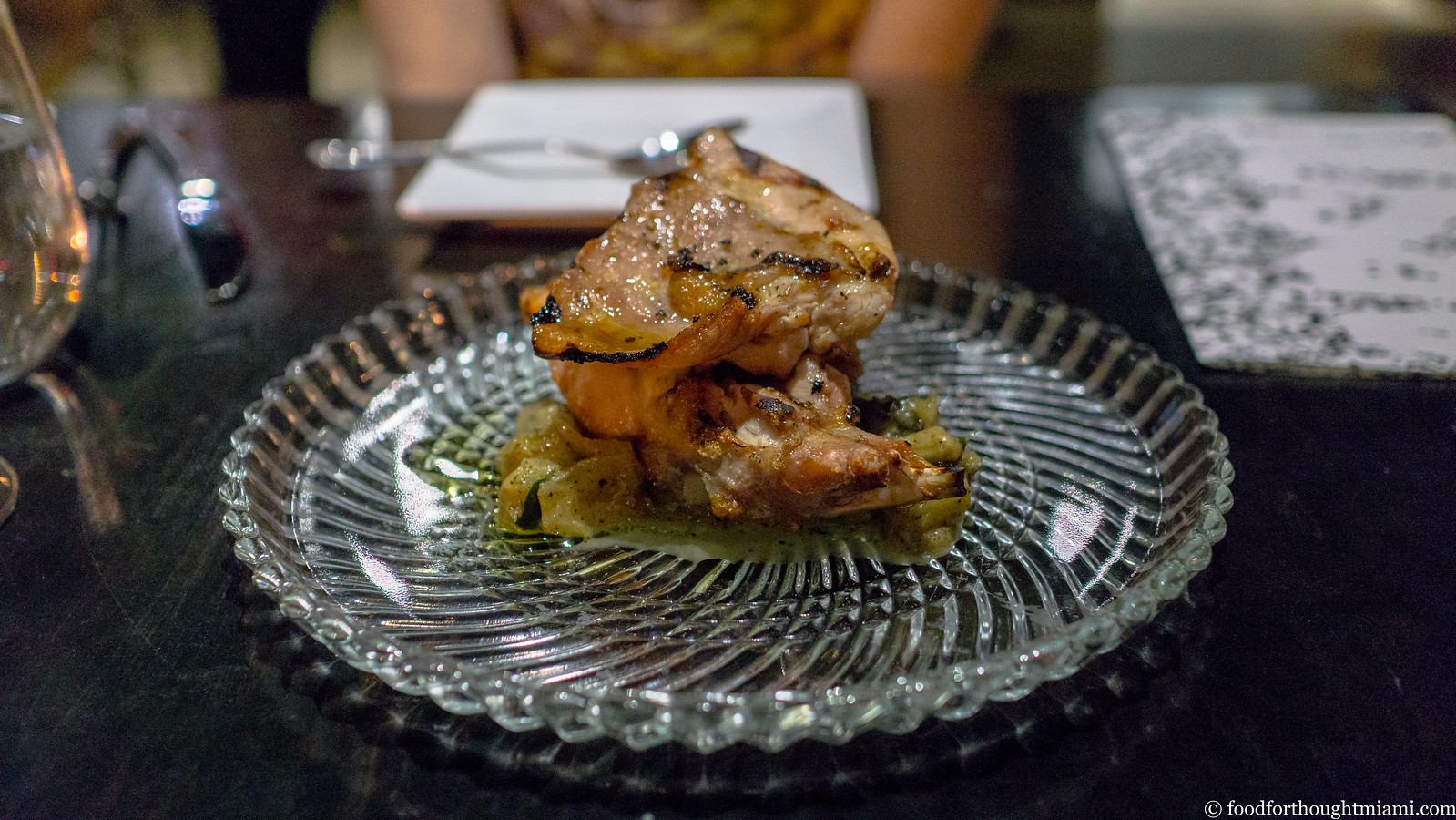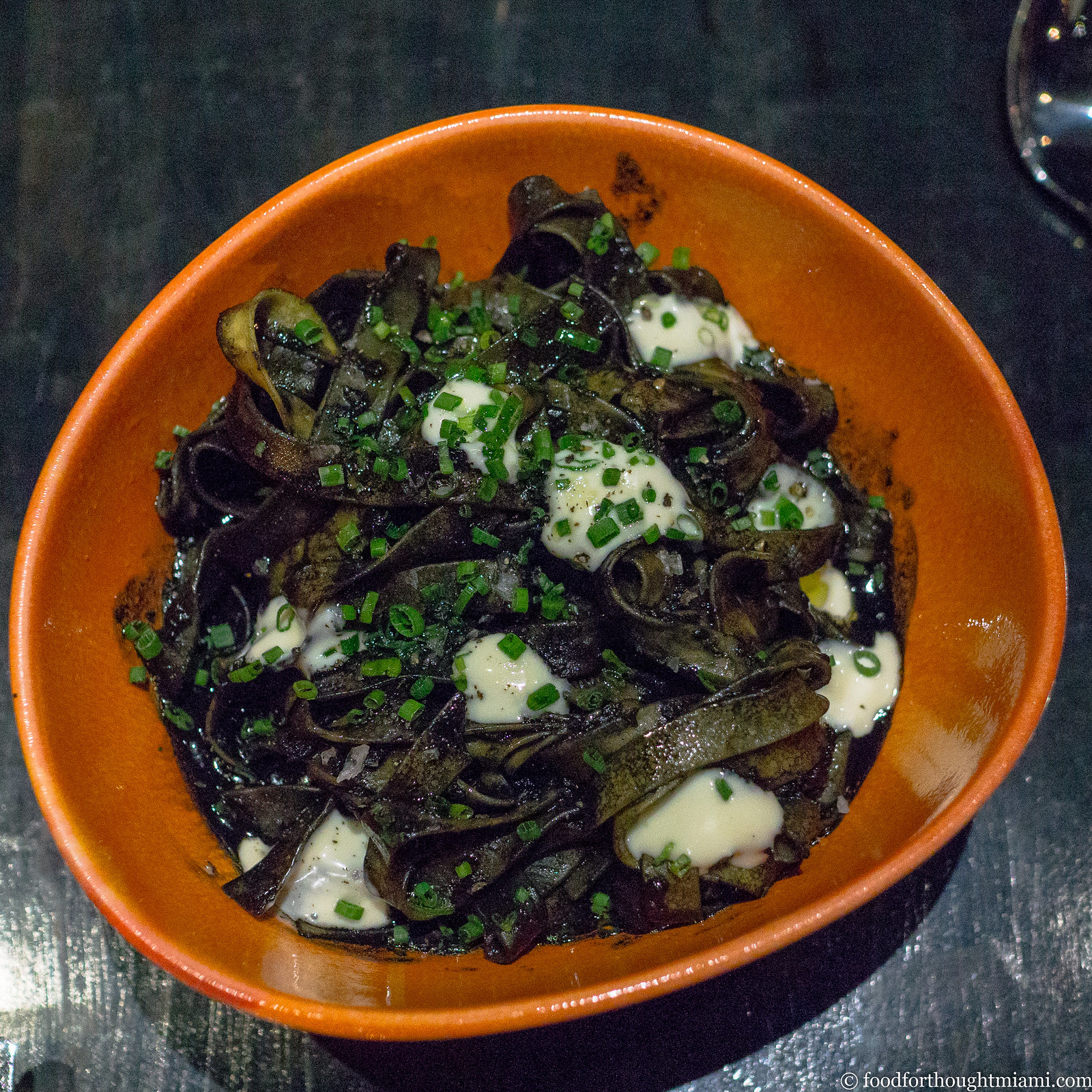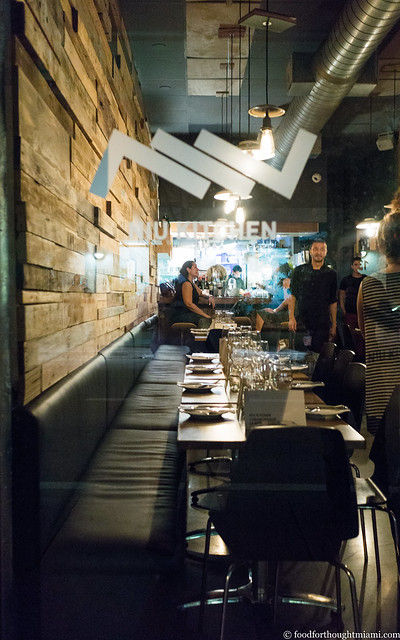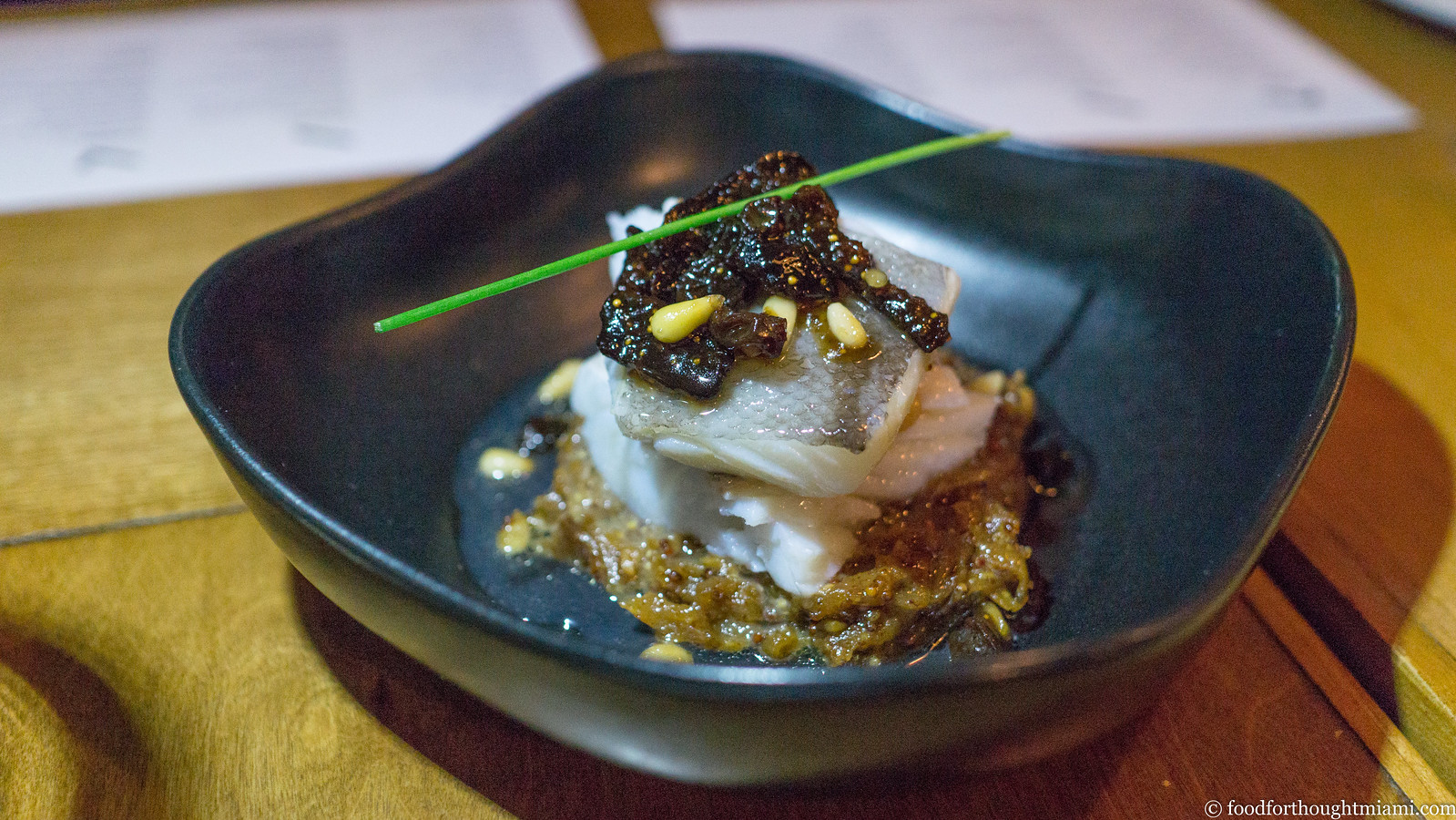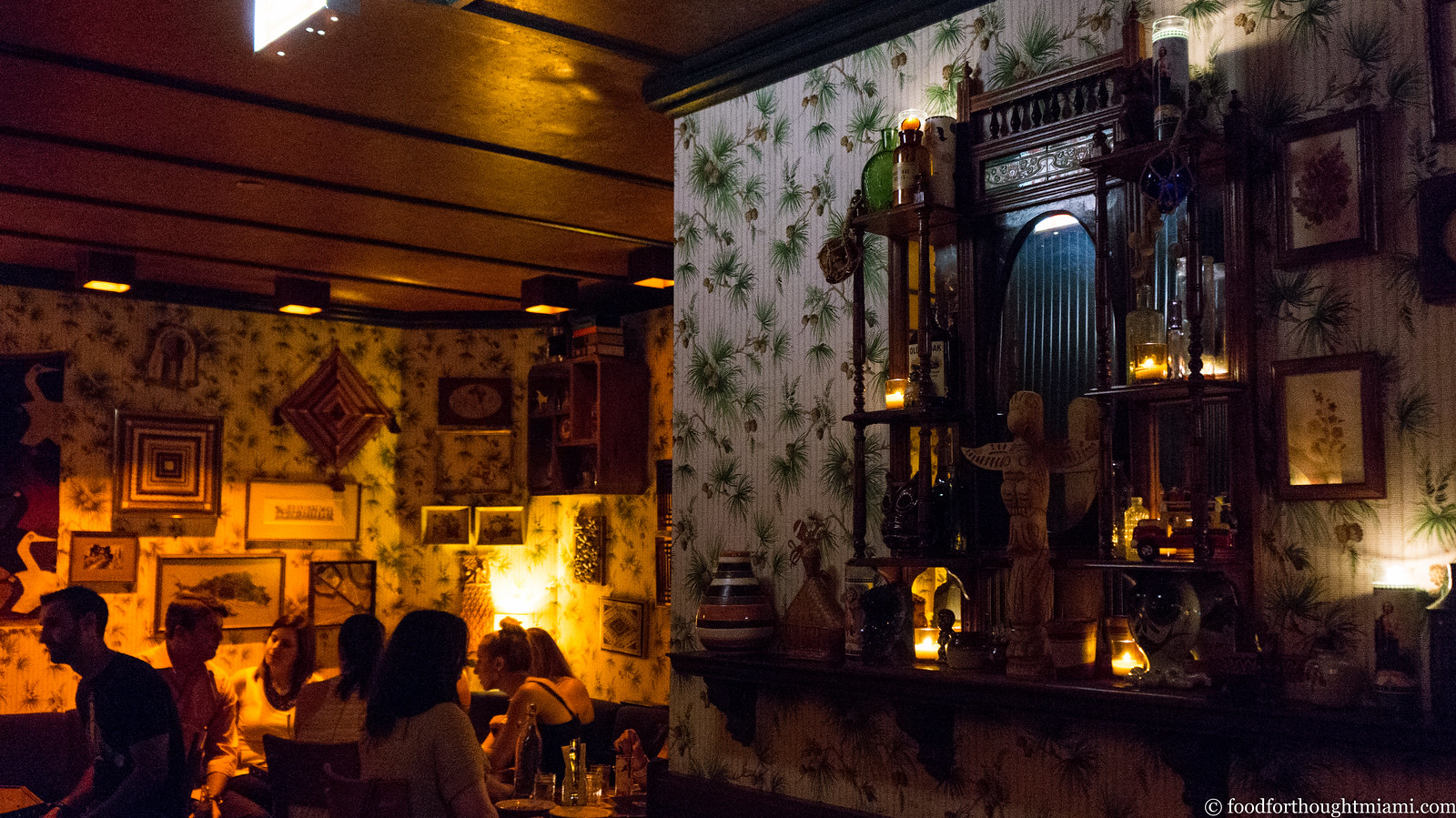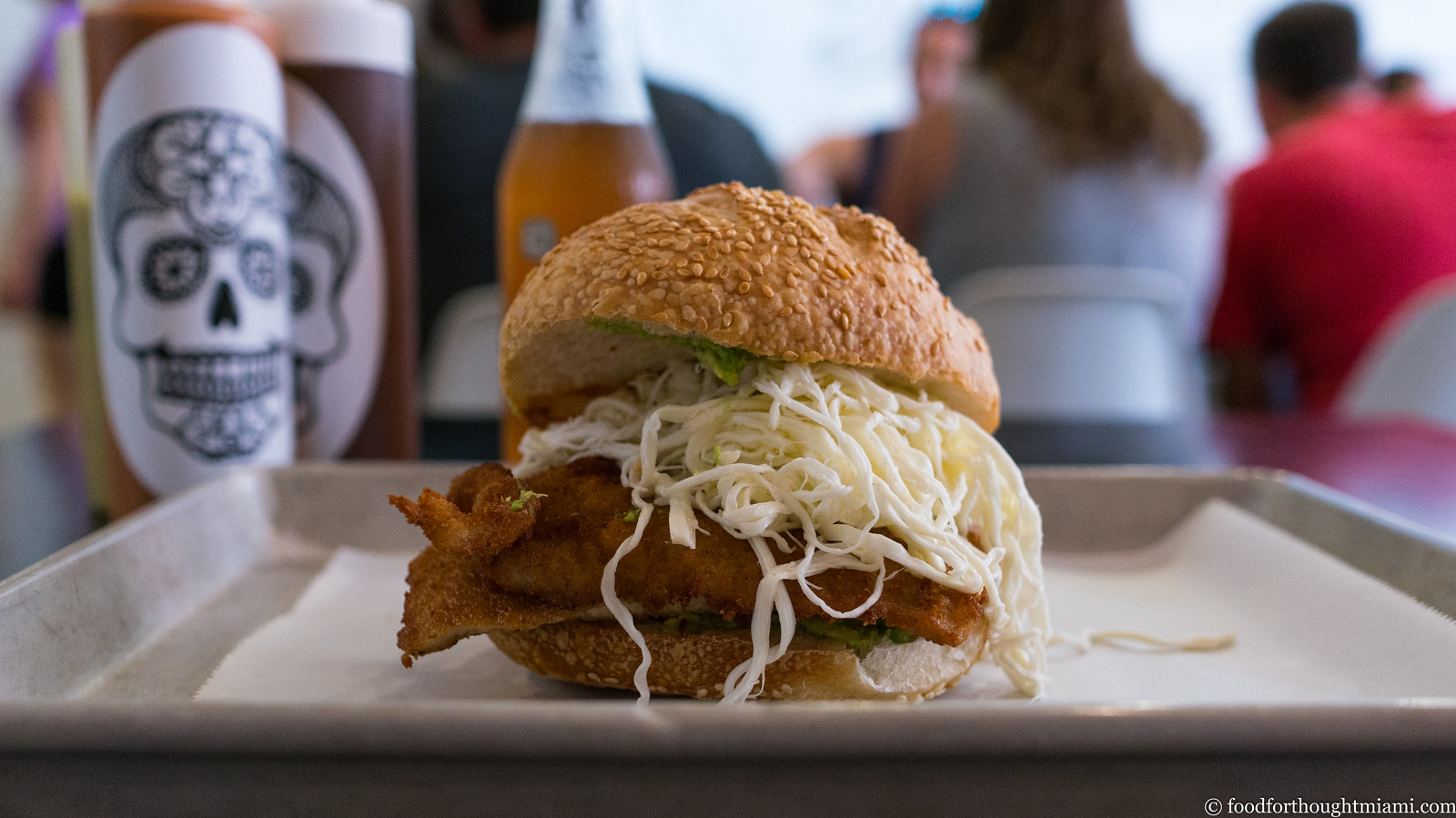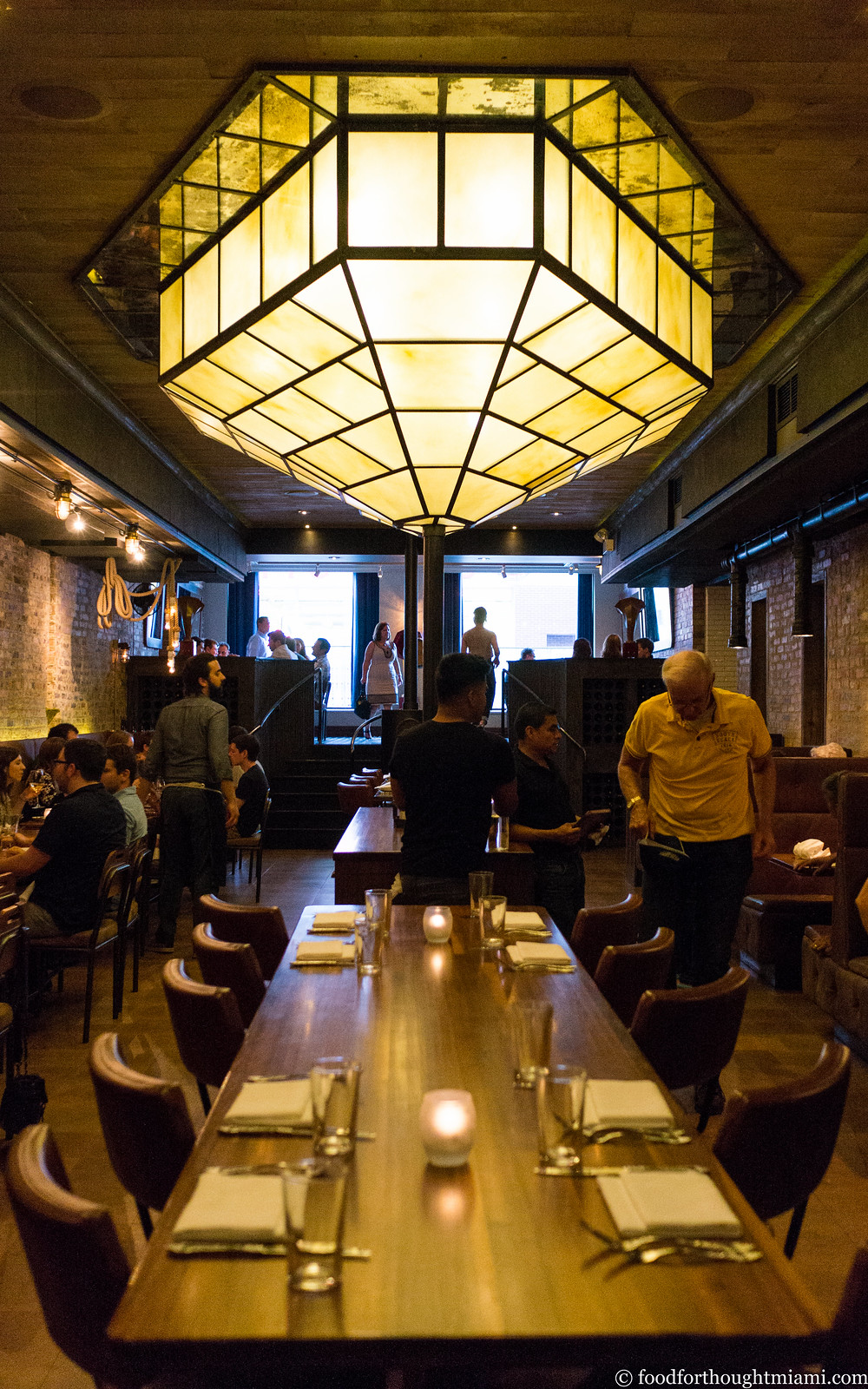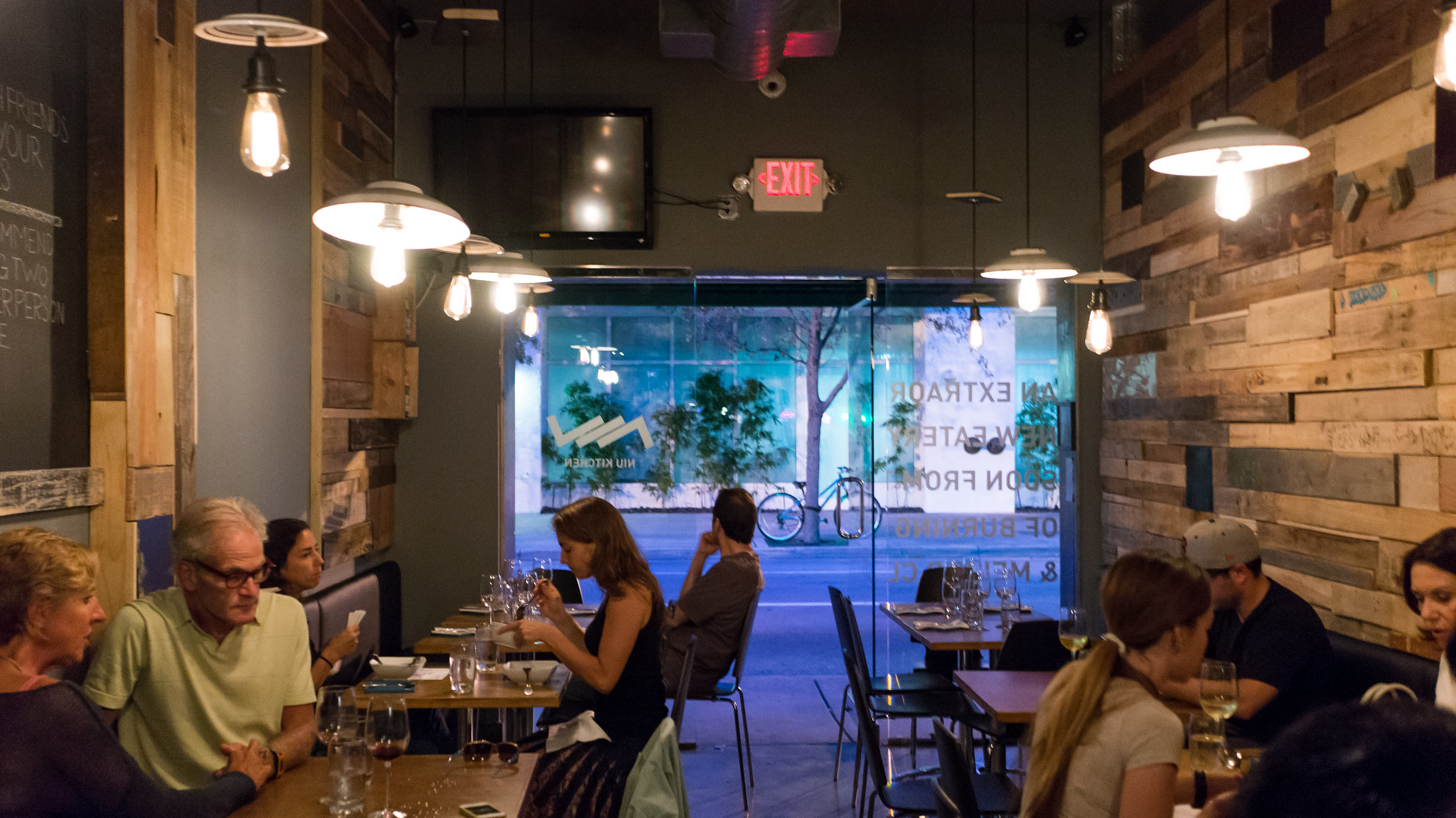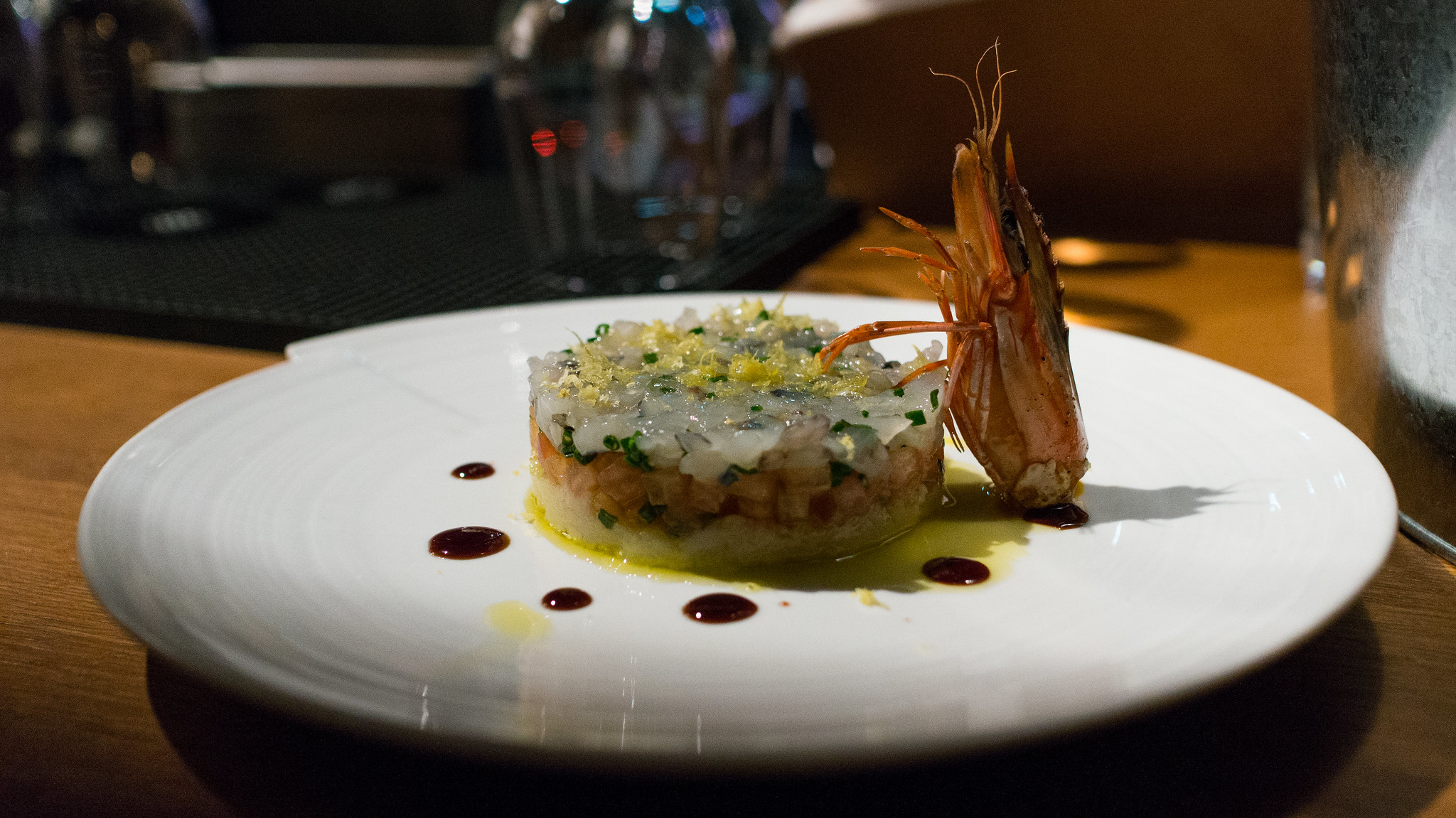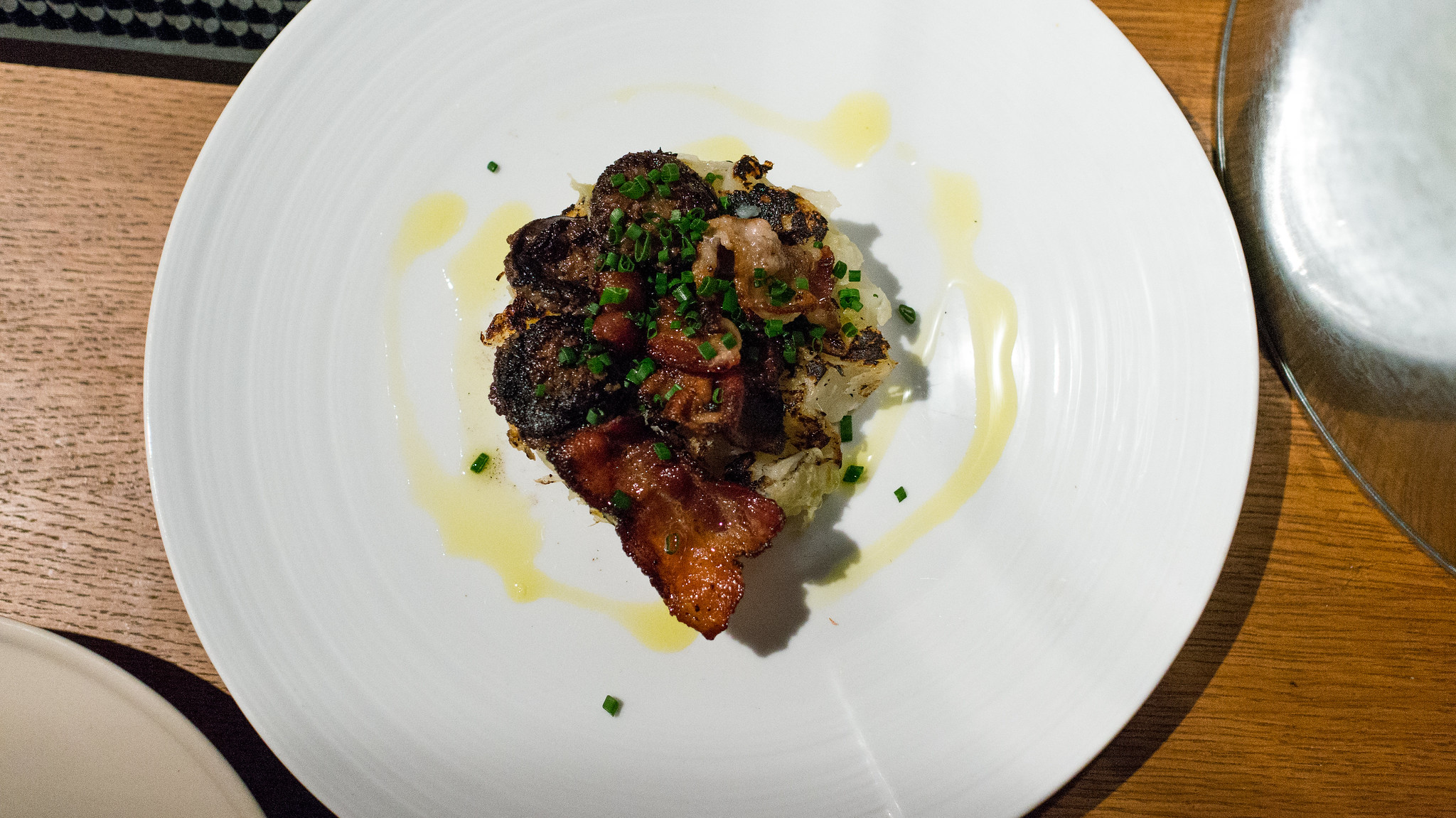Showing posts with label Spanish. Show all posts
Showing posts with label Spanish. Show all posts
Wednesday, October 18, 2017
é by José Andrés | Las Vegas
There's a phenomenon on social media lately that whenever a celebrity chef expresses an opinion on political or social issues, a chorus of those whose sensibilities diverge insist that the chef should "stay in their lane." In other words, talk about food all you want, but keep your politics to yourself. The reaction seems inherently ridiculous to me – if you don't like it, the "unfollow" button is a simple, elegant solution – and hypocritical. Unless, that is, all these "stay in your lane" folks are actually career political scientists themselves, or perhaps professional life coaches.
I bring this up here because Chef José Andrés is a powerful retort to that kind of nonsense, someone whose talk has been backed up by meaningful, thoughtful action. The day after Hurricane Harvey cleared Texas, he was in Houston feeding people. A month later when Hurricane Maria decimated Puerto Rico, he was there within days serving meals. Over the past weeks, he's mobilized a brigade of food trucks and canteen kitchens to serve 100,000 meals a day, while getting minimal support from the federal government, in a territory with an almost entirely broken infrastructure.[1]
But this shouldn't come as a surprise. His charity work is not simply a reaction to recent events, but a commitment that dates back to at least 2010, when he founded a non-profit, World Central Kitchen, as a response to a devastating earthquake in Haiti. When, in mid-2016, then-candidate Trump described Mexicans as criminals and rapists, Andrés – an immigrant and naturalized U.S. citizen himself – didn't just gripe about it on Twitter. He pulled out of a multi-million dollar restaurant deal at a Trump property in DC, risking the inevitable lawsuit from the litigation-happy candidate. (Andrés countersued, and the case settled in April on undisclosed terms.)
All of which is to say: José Andrés can cruise in any lane he wants, as far as I'm concerned.
While the work he's doing now in Puerto Rico is infinitely more important, those lanes do actually include chef and restaurateur as well. Andrés' restaurants include the Michelin two-star Minibar, along with a mini-empire of places in DC, LA, Miami, and Las Vegas, the last of which I visited recently for a conference.[2] While there, I squeezed in a dinner at é by José Andrés, an 8-seat "restaurant within a restaurant" inside Jaleo at the Cosmopolitan.
(You can see all my pictures in this é by José Andrés - Las Vegas flickr set).
The format of é is patterned after the original iteration of Minibar in DC with a dollop of Vegas glitz. Its roughly 20-course tasting menu is unabashedly inspired by the creations of Andrés' mentor, Ferran Adrià, with whom Andrés worked at El Bulli in Spain before going on to tremendous success in the U.S. I'd visited é once before, though I hadn't realized how long ago it had been – nearly six years. The room, centered by a polished metal chef's counter surrounded by walls lined with tiny drawers and odd tchotchkes, hasn't changed much. One of the chefs said it was meant to make you feel like "You're inside Chef Andrés' head." (It kind of does.) The menu was almost entirely different, though there were some echoes of prior meals.
Guests are corralled at a table in Jaleo and offered a drink before the dinner at é starts. After a few minutes, the hostess divulges that the centerpiece on the table is also the first course: a cracker flavored with black olive, stuck with edible flowers.
Then upon entering the cloistered dining room, a cocktail: sangria, frozen and powdered to a slushie-like consistency, with compressed melon, sour cherry pearls, and fresh mint leaves.[3]
A cheese course of sorts: a soft-frozen manchego and beet rose topping a walnut cracker, "stones" of idiazabal cheese with a jamón and rosemary glaze nestled atop a bowl of river stones; and a "pizza" of San Simon cheese topped with oregano cream, dried tomato, and fresh shaved truffle.
(continued ...)
Monday, March 13, 2017
first thoughts: Arson | Downtown Miami
I can't believe it's already been nearly three years since a small, curious spot called Niu Kitchen opened in downtown Miami, on a nondescript block across from Miami-Dade College. Despite its diminutive size, Niu manages to turn out Catalan-inspired food that is more creative, and more delicious, than many local restaurants with much bigger spaces and budgets. Now, the team of chef Deme Lomas and manager Karina Iglesias has doubled down, opening Arson just a few doors down.
The roomier space may be twice the size of Niu, and as the name suggests, the focus is fire: pretty much every dish is touched by flame or smoke, mostly generated by the Josper, a Spanish-made, charcoal-fired oven / grill rig that is fast becoming many chefs' favorite new plaything. And while Niu remains more or less faithful to the Catalan theme, Arson is unbounded by genre: they'll set fire to anything.
(You can see all my pictures in this Arson - Miami flickr set).
The menu right now is pretty short and tight: four appetizer-sized dishes, four ocean-based proteins, four land-based proteins, rounded out by a few more items listed on a blackboard as daily specials. Prices tend to cluster around the $20 mark, and portion sizes run small, so that you might consider splitting an extra item among two people if you show up with a healthy appetite.
We started with a couple of the smaller dishes (Arson is a "dishes are meant for sharing and come out as they're ready" kind of place; for our meal, apps came out before more substantial dishes, though not necessarily at the same time). Roasted red peppers, served at room temperature, were tender, sweet, and a little bit smoky, blanketed with garlic oil, grated hard boiled egg, and crunchy migas. I liked this a lot. Another cool dish, anticipating summer: a chilled roasted vegetable soup, thick and creamy like a salmorejo, garnished with a crispy rice cracker bearing a payload of cinnamon and curry powder. Shatter the cracker and the warm spices perfume the bowl.
Spanish octopus looks like something from mid-aughts El Bulli, and tastes a bit like it too: a fat tentacle burnished on the grill, a broad stripe of frothy star anise infused cream, transparent cubes of tomato gelatin, dots of spicy (pimentón?) aioli. The octopus happens to be grilled just right, and the unusual accompaniments somehow work together.
We order a couple of grilled meats from the chalkboard: the Spanish rabbit, and the secreto de iberico (there's also a whole fish, a duck, and a couple steaks, in addition to what's on the printed menu). The cut of rabbit is from the plump leg, which I've usually seen braised or confited, and there's a reason: this is a tight, muscular piece of meat, and slow cooking in liquid or fat lets it slacken and relax. Here, it's flavorful and juicy – and won't be mistaken for chicken – but still somewhat tough.
The secreto, on the other hand, is pure joy. This "butcher's secret" cut eats like a skirt steak of pork, with a rippled, chewy but still giving texture and deep, intense flavor. It would be perfect as is – just grilled and assertively salted – but Deme adds little buttons of pungent garlic confit and cubes of tart apple around the edges of the plate.
As we're almost finishing, Karina comes over from Niu and spots us (full disclosure: we spent lots of time at the counter at Red Light with Karina stalling for time, entertaining our kids, and plying us with beers as Kris Wessel sweated away in the kitchen), and sends over one more dish. It's a pasta: tagliatelle dyed black with squid ink, studded with briny nubbins of grilled cuttlefish, awash in a tomato sofrito, and dotted with creamy aioli. It's excellent. It also fills the spot that might otherwise have been occupied by one of a few desserts that are available, which also make some use of the Josper's flames.
Like its sibling Niu Kitchen, Arson is a quirky place, and the short, simple menu can make it a bit of a challenge to cobble together a meal. But it's interesting, intriguing stuff, most of it quite delicious, and it's great to see something new from the Niu crew.
Arson
104 N.E. 2nd Avenue, Miami, Florida
786.717.6711
The roomier space may be twice the size of Niu, and as the name suggests, the focus is fire: pretty much every dish is touched by flame or smoke, mostly generated by the Josper, a Spanish-made, charcoal-fired oven / grill rig that is fast becoming many chefs' favorite new plaything. And while Niu remains more or less faithful to the Catalan theme, Arson is unbounded by genre: they'll set fire to anything.
(You can see all my pictures in this Arson - Miami flickr set).
The menu right now is pretty short and tight: four appetizer-sized dishes, four ocean-based proteins, four land-based proteins, rounded out by a few more items listed on a blackboard as daily specials. Prices tend to cluster around the $20 mark, and portion sizes run small, so that you might consider splitting an extra item among two people if you show up with a healthy appetite.
We started with a couple of the smaller dishes (Arson is a "dishes are meant for sharing and come out as they're ready" kind of place; for our meal, apps came out before more substantial dishes, though not necessarily at the same time). Roasted red peppers, served at room temperature, were tender, sweet, and a little bit smoky, blanketed with garlic oil, grated hard boiled egg, and crunchy migas. I liked this a lot. Another cool dish, anticipating summer: a chilled roasted vegetable soup, thick and creamy like a salmorejo, garnished with a crispy rice cracker bearing a payload of cinnamon and curry powder. Shatter the cracker and the warm spices perfume the bowl.
Spanish octopus looks like something from mid-aughts El Bulli, and tastes a bit like it too: a fat tentacle burnished on the grill, a broad stripe of frothy star anise infused cream, transparent cubes of tomato gelatin, dots of spicy (pimentón?) aioli. The octopus happens to be grilled just right, and the unusual accompaniments somehow work together.
We order a couple of grilled meats from the chalkboard: the Spanish rabbit, and the secreto de iberico (there's also a whole fish, a duck, and a couple steaks, in addition to what's on the printed menu). The cut of rabbit is from the plump leg, which I've usually seen braised or confited, and there's a reason: this is a tight, muscular piece of meat, and slow cooking in liquid or fat lets it slacken and relax. Here, it's flavorful and juicy – and won't be mistaken for chicken – but still somewhat tough.
The secreto, on the other hand, is pure joy. This "butcher's secret" cut eats like a skirt steak of pork, with a rippled, chewy but still giving texture and deep, intense flavor. It would be perfect as is – just grilled and assertively salted – but Deme adds little buttons of pungent garlic confit and cubes of tart apple around the edges of the plate.
As we're almost finishing, Karina comes over from Niu and spots us (full disclosure: we spent lots of time at the counter at Red Light with Karina stalling for time, entertaining our kids, and plying us with beers as Kris Wessel sweated away in the kitchen), and sends over one more dish. It's a pasta: tagliatelle dyed black with squid ink, studded with briny nubbins of grilled cuttlefish, awash in a tomato sofrito, and dotted with creamy aioli. It's excellent. It also fills the spot that might otherwise have been occupied by one of a few desserts that are available, which also make some use of the Josper's flames.
Like its sibling Niu Kitchen, Arson is a quirky place, and the short, simple menu can make it a bit of a challenge to cobble together a meal. But it's interesting, intriguing stuff, most of it quite delicious, and it's great to see something new from the Niu crew.
Arson
104 N.E. 2nd Avenue, Miami, Florida
786.717.6711
Saturday, December 12, 2015
Cobaya Niu with Chef Deme Lomas
A couple weeks ago, we squeezed thirty guinea pigs in there for a Cobaya dinner and let Chef Lomas do his thing. He went entirely off-menu for us, but still created dishes that were faithful to his idiom. It was a really enjoyable dinner. Here's what we had:
(You can see all my pictures in this Cobaya Niu flickr set).
To start things off, a cup of golden creamed leek soup, topped with a drizzle of olive oil, a spray of crispy fried julienned leeks, and a little dollop of herring roe. Simple, but richly flavored.
A plump seared scallop, with a burnished crusty edge on one side, served over silky cauliflower purée with cubes of a pomegranate gel. I defer to SteveBM in matters involving scallops (one of his favorite things when done right; one that will draw his scorn if not): he liked it a lot. I concur.
(continued ...)
Monday, November 30, 2015
best thing i ate last week: cod confit a la catalana at Cobaya Niu
Sometimes I will read a dish description and have no clue how it could possibly taste good. This was one of those. The chef was Deme Lomas, the spot was Niu Kitchen, which was playing host to our 58th Cobaya dinner on Monday night. The dish was cod with dry figs, roasted onions, mustard and honey. Why would anyone put all those sweet things with a piece of fish?
Shows what I know. Here, the residual saltiness of the rehydrated bacalao, all unctuous and shiny, was balanced against the sweetness of the figs and honey; the zing of mustard for a bit of contrast, a nest of golden caramelized onions as a bridge between savory and sweet. The combination of salt cod and honey actually has a long history in Catalan cooking, which is Chef Lomas' focus at Niu Kitchen. Here's Colman Andrews in his book "Catalan Cuisine: Europe's Last Great Culinary Secret":
Shows what I know. Here, the residual saltiness of the rehydrated bacalao, all unctuous and shiny, was balanced against the sweetness of the figs and honey; the zing of mustard for a bit of contrast, a nest of golden caramelized onions as a bridge between savory and sweet. The combination of salt cod and honey actually has a long history in Catalan cooking, which is Chef Lomas' focus at Niu Kitchen. Here's Colman Andrews in his book "Catalan Cuisine: Europe's Last Great Culinary Secret":
I remember a game I used to play with friends, in younger years, of trying to invent the most unlikely or revolting-sounding food combinations possible – things, I recall, like raw oysters with chocolate sauce and pineapple-clam cake. This dish, I imagine, must sound a bit like one of those to many readers – or at least like some mindless nouvelle (or nova) excess. In fact, though, salt cod with honey is neither nouvelle nor revolting. It's an old Catalan mountain dish, first mentioned in print in the seventeenth century and said to have been an invention of necessity – the union of two easily stored, well-preserved ingredients, eaten together simply to provide a kind of calorie-loading, essential for survival in cold climates during the cropless winter months.The most exciting dishes can be those you don't expect to work. This one was the best thing I ate last week.
Tuesday, July 28, 2015
a weekend of eating (and other things) in Chicago
The idea was to break up the long hot summer by spending the weekend someplace cooler than Miami. Of course, our visit to Chicago coincided with a heatwave that brought 90 degree temperatures right along with us. So that part didn't go as planned.
My last brief visit to Chicago focused mostly on high-end dining – Alinea (pictures here) and the now-closed L2O (pictures here), though I also managed to squeeze into a seat at Au Cheval (pictures here) and snag one of their awesome burgers. But this trip was planned on fairly short notice, too late to book seats at a couple other places high on my to-do list: Grace and 42 Grams in particular.
So the question was, where to go in Chicago where we could book a table on about a week's notice?[1] I aimed a bit lower and made reservations at a couple newer additions to Chicago's dining constellation – Salero and Momotaro – as well as a place I've been hoping to try for a couple years, Trenchermen.
Other than the weather, it all worked out pretty well. Here's a brief travelogue of where we went and what we did.
Our very first stop was at the Broken Shaker (see all my Broken Shaker pics here), a newly opened Chicago outpost of Miami's craft cocktail bar in the Freehand Hotel. I may have brought the Miami weather with me, but the Bar Lab boys, Elad Zvi and Gabriel Orta, seem to have brought all the rest of the Magic City to the Windy City.[2] They've done an uncanny job of capturing the look and feel of the original bar in the old 1930's era Miami Beach Indian Creek Hotel. They get the drinks right too, with some Miami staples (Cocoa Puff Old Fashioned) mixed in with some Chicago-inspired cocktails. A Devonshire Fizz, with Rare Tea blood orange scented green tea, Campari, grapefruit soda, vermouth and Milagro tequila, took the edge off a steamy Chicago afternoon. We even ran into Elad at the bar, a day before he headed to New Orleans for Tales of the Cocktail and picked up a well-deserved award for Best American Hotel Bar for Shaker Miami.
Broken Shaker Chicago
19 East Ohio Street, Chicago, Illinois 312.940.3699
From there, we headed to dinner at Salero (see all my Salero pics here), a Spanish restaurant which opened about a year ago in the West Loop, which is becoming Chicago's restaurant row. The chef is Ashlee Aubin, an alumnus of (now-closed) Zealous and Alinea who also runs the kitchen at Wood. At Salero, Aubin mixes old and new, with lots of Basque influences in particular on display.
Though Spanish often means tapas, Salero's menu eschews the now-ubiquitous "small plates" format for more traditional appetizers ("entradas") and entrées ("platos fuertes"). Still, there is also a bar menu of pintxos (the Basque tapas equivalent) which, if you ask nicely, you can also avail yourself of in the dining room. It was from there that we ordered a couple "Gildas," a simple and wonderful pintxo of anchovies, manzanilla olives and guindilla peppers found throughout San Sebastian and Bilbao.[3] Also from the pintxos menu, a sampling of Spain's outstanding "conservas," or canned seafood products: berberechos (cockles), served simply with bread, butter and lemon, and still tasting like they were straight from the sea.
A variation on calçots looked to the Catalan instead of the Basque country for inspiration; the brick-red, mildly spicy romesco sauce was right on target, but the grilled spring onions were all crispy greens and none of the tender, sweet whites that are the highlight of the traditional dish.[4] A rabbit terrine looked somewhat sloppy and disheveled, but I would have ordered anything that came with the excellent cheese-stuffed, tempura-fried padron peppers that accompanied it. And I loved Salero's modernized version of callos a la madrileña, which was the Best Thing I Ate Last Week (last week).
Salero
621 W. Randolph Street, Chicago, Illinois 312.466.1000

The following morning we headed up to Lincoln Park, where the Green City Market hosts a Saturday farmers market. We grabbed a pint of some Michigan berries from Mick Klug Farm and a buttermilk doughnut from the Doughnut Vault truck parked along the street and had our breakfast on a park bench.
Just down the street is the Chicago History Museum, which had a fantastic exhibit of photos by Vivian Maier, a nanny for several Chicago families who in her spare time took pictures all around the city during the 1950's through 1970's. This was really a stunning exhibit with an odd backstory. Maier apparently didn't show her photographs to anyone during her lifetime, and at some point in her life, a storage locker with thousands of negatives was auctioned off after being seized by a landlord. In 2007 the negatives were discovered in a thrift auction house and finally made their way to the public eye.[5]
We wound up back in the West Loop for lunch, and after poking our noses into Stephanie Izard's Little Goat Diner (one hour wait) and Au Cheval (three hour wait!), I grabbed a sandwich at Cemitas Puebla instead. I'd never had a proper cemita before and my expectations were high – perhaps too high. I went with the milanesa, and it was a good, satisfying $8 lunch, but nothing that changed my life in any meaningful way. Nice crispy, juicy pork loin, on a nice puffy, crusty-shelled roll, but it had too much cheese, not enough avocado, and barely a whisper of any chipotle sauce. I doctored it with the tableside salsas, but it wasn't enough to make any magic.
Cemitas Puebla
817 West Fulton Market, Chicago, Illinois 312.455.9200

For dinner, we headed over to Wicker Park, past the teeming hordes filling the outdoor patio and stuffing their faces with tacos at Big Star, and around the corner to the somewhat more sedate Trenchermen (see all my Trenchermen pictures here). The entrance looks like a Victorian scientist's cabinet of curiosities, with terrariums mounted on the wall and shelves stuffed with odd knick-knacks. Down a half-flight of stairs, you'll find yourself in the lengthy bar, which occupies a space that used to be a Russian bathhouse and still feels a bit like it, with white subway tiles lining the walls of the subterranean space. The dining room occupies a parallel room dominated by huge octagonal lights that look like they were poached from a Frank Lloyd Wright project.
The food, from Chef Pat Sheerin,[6] is equally eccentric, often referencing multiple cuisines at once, even on the same plate. Notwithstanding the heartiness suggested by the restaurant's name, most dishes tread pretty lightly. The menu is divided into sections for cold and warm starters and then mains, but a four-course prix fixe option lets you choose two starters, a main and a dessert, which is about the right amount of food.
Salt and pepper squid, served over a salad of cubed eggplant and cucumber with spicy chiles, felt Asian and Middle Eastern at the time, sichuan peppercorn bringing that tingly "ma la" sensation, cumin vinaigrette adding that warm B.O. funk. That may not be the most appetizing description, but it was a delicious dish. A plate of grilled carrots paired with English pea falafel balls and an orange and olive oil "jam" also tasted like it had blown through the Mediterranean on its way to the table. A salad of kale and pickled escabeche vegetables napped with an avocado goddess dressing and sprinkled with toasted pumpkin seeds felt appropriately virtuous.
If Trenchermen has a signature dish, it may be the "pickle tots" – a mash-up of tater tots and fried pickles, served with a hot pink yogurt infused with dehydrated red onion, and ribbons of cured and smoked chicken "bresaola" (you can watch the Sheerin brothers prepare the dish here). I can see why they'd have trouble taking it off the menu – it's a great dish, simultaneously contemporary and nostalgic.
While you can go meaty at Trenchermen, with a double burger, beef shoulder, or leg of lamb, it's also a vegetarian-friendly place, with not one but two plant-based main course options. Wanting to eat light, we tried both. I preferred the toasted oats with mapo tofu, the tofu dusted with powdered chiles in a bowl rounded out with lentils, eggplant and toasted almonds. The roasted broccoli, with vadouvan spice, sprouted black chickpeas, a broccoli and hemp seed hummus and hoisin sauce, was not as good, the broccoli a bit woody and tough, the spicing a bit too mild-mannered. But the dessert – a Basque cake, served over an almond crumble and a smear of lemon curd, and crowned with a scoop of olive oil poppy seed ice cream – more than made up for it. I don't usually get that excited over cake, but this one, crusty on the outside and custardy within, was exciting stuff.
Trenchermen
2039 W. North Avenue, Chicago, Illinois 773.661.1540

(continued ...)
My last brief visit to Chicago focused mostly on high-end dining – Alinea (pictures here) and the now-closed L2O (pictures here), though I also managed to squeeze into a seat at Au Cheval (pictures here) and snag one of their awesome burgers. But this trip was planned on fairly short notice, too late to book seats at a couple other places high on my to-do list: Grace and 42 Grams in particular.
So the question was, where to go in Chicago where we could book a table on about a week's notice?[1] I aimed a bit lower and made reservations at a couple newer additions to Chicago's dining constellation – Salero and Momotaro – as well as a place I've been hoping to try for a couple years, Trenchermen.
Other than the weather, it all worked out pretty well. Here's a brief travelogue of where we went and what we did.
Our very first stop was at the Broken Shaker (see all my Broken Shaker pics here), a newly opened Chicago outpost of Miami's craft cocktail bar in the Freehand Hotel. I may have brought the Miami weather with me, but the Bar Lab boys, Elad Zvi and Gabriel Orta, seem to have brought all the rest of the Magic City to the Windy City.[2] They've done an uncanny job of capturing the look and feel of the original bar in the old 1930's era Miami Beach Indian Creek Hotel. They get the drinks right too, with some Miami staples (Cocoa Puff Old Fashioned) mixed in with some Chicago-inspired cocktails. A Devonshire Fizz, with Rare Tea blood orange scented green tea, Campari, grapefruit soda, vermouth and Milagro tequila, took the edge off a steamy Chicago afternoon. We even ran into Elad at the bar, a day before he headed to New Orleans for Tales of the Cocktail and picked up a well-deserved award for Best American Hotel Bar for Shaker Miami.
Broken Shaker Chicago
19 East Ohio Street, Chicago, Illinois 312.940.3699
From there, we headed to dinner at Salero (see all my Salero pics here), a Spanish restaurant which opened about a year ago in the West Loop, which is becoming Chicago's restaurant row. The chef is Ashlee Aubin, an alumnus of (now-closed) Zealous and Alinea who also runs the kitchen at Wood. At Salero, Aubin mixes old and new, with lots of Basque influences in particular on display.
Though Spanish often means tapas, Salero's menu eschews the now-ubiquitous "small plates" format for more traditional appetizers ("entradas") and entrées ("platos fuertes"). Still, there is also a bar menu of pintxos (the Basque tapas equivalent) which, if you ask nicely, you can also avail yourself of in the dining room. It was from there that we ordered a couple "Gildas," a simple and wonderful pintxo of anchovies, manzanilla olives and guindilla peppers found throughout San Sebastian and Bilbao.[3] Also from the pintxos menu, a sampling of Spain's outstanding "conservas," or canned seafood products: berberechos (cockles), served simply with bread, butter and lemon, and still tasting like they were straight from the sea.
A variation on calçots looked to the Catalan instead of the Basque country for inspiration; the brick-red, mildly spicy romesco sauce was right on target, but the grilled spring onions were all crispy greens and none of the tender, sweet whites that are the highlight of the traditional dish.[4] A rabbit terrine looked somewhat sloppy and disheveled, but I would have ordered anything that came with the excellent cheese-stuffed, tempura-fried padron peppers that accompanied it. And I loved Salero's modernized version of callos a la madrileña, which was the Best Thing I Ate Last Week (last week).
Salero
621 W. Randolph Street, Chicago, Illinois 312.466.1000
The following morning we headed up to Lincoln Park, where the Green City Market hosts a Saturday farmers market. We grabbed a pint of some Michigan berries from Mick Klug Farm and a buttermilk doughnut from the Doughnut Vault truck parked along the street and had our breakfast on a park bench.
Just down the street is the Chicago History Museum, which had a fantastic exhibit of photos by Vivian Maier, a nanny for several Chicago families who in her spare time took pictures all around the city during the 1950's through 1970's. This was really a stunning exhibit with an odd backstory. Maier apparently didn't show her photographs to anyone during her lifetime, and at some point in her life, a storage locker with thousands of negatives was auctioned off after being seized by a landlord. In 2007 the negatives were discovered in a thrift auction house and finally made their way to the public eye.[5]
We wound up back in the West Loop for lunch, and after poking our noses into Stephanie Izard's Little Goat Diner (one hour wait) and Au Cheval (three hour wait!), I grabbed a sandwich at Cemitas Puebla instead. I'd never had a proper cemita before and my expectations were high – perhaps too high. I went with the milanesa, and it was a good, satisfying $8 lunch, but nothing that changed my life in any meaningful way. Nice crispy, juicy pork loin, on a nice puffy, crusty-shelled roll, but it had too much cheese, not enough avocado, and barely a whisper of any chipotle sauce. I doctored it with the tableside salsas, but it wasn't enough to make any magic.
Cemitas Puebla
817 West Fulton Market, Chicago, Illinois 312.455.9200
For dinner, we headed over to Wicker Park, past the teeming hordes filling the outdoor patio and stuffing their faces with tacos at Big Star, and around the corner to the somewhat more sedate Trenchermen (see all my Trenchermen pictures here). The entrance looks like a Victorian scientist's cabinet of curiosities, with terrariums mounted on the wall and shelves stuffed with odd knick-knacks. Down a half-flight of stairs, you'll find yourself in the lengthy bar, which occupies a space that used to be a Russian bathhouse and still feels a bit like it, with white subway tiles lining the walls of the subterranean space. The dining room occupies a parallel room dominated by huge octagonal lights that look like they were poached from a Frank Lloyd Wright project.
The food, from Chef Pat Sheerin,[6] is equally eccentric, often referencing multiple cuisines at once, even on the same plate. Notwithstanding the heartiness suggested by the restaurant's name, most dishes tread pretty lightly. The menu is divided into sections for cold and warm starters and then mains, but a four-course prix fixe option lets you choose two starters, a main and a dessert, which is about the right amount of food.
Salt and pepper squid, served over a salad of cubed eggplant and cucumber with spicy chiles, felt Asian and Middle Eastern at the time, sichuan peppercorn bringing that tingly "ma la" sensation, cumin vinaigrette adding that warm B.O. funk. That may not be the most appetizing description, but it was a delicious dish. A plate of grilled carrots paired with English pea falafel balls and an orange and olive oil "jam" also tasted like it had blown through the Mediterranean on its way to the table. A salad of kale and pickled escabeche vegetables napped with an avocado goddess dressing and sprinkled with toasted pumpkin seeds felt appropriately virtuous.
If Trenchermen has a signature dish, it may be the "pickle tots" – a mash-up of tater tots and fried pickles, served with a hot pink yogurt infused with dehydrated red onion, and ribbons of cured and smoked chicken "bresaola" (you can watch the Sheerin brothers prepare the dish here). I can see why they'd have trouble taking it off the menu – it's a great dish, simultaneously contemporary and nostalgic.
While you can go meaty at Trenchermen, with a double burger, beef shoulder, or leg of lamb, it's also a vegetarian-friendly place, with not one but two plant-based main course options. Wanting to eat light, we tried both. I preferred the toasted oats with mapo tofu, the tofu dusted with powdered chiles in a bowl rounded out with lentils, eggplant and toasted almonds. The roasted broccoli, with vadouvan spice, sprouted black chickpeas, a broccoli and hemp seed hummus and hoisin sauce, was not as good, the broccoli a bit woody and tough, the spicing a bit too mild-mannered. But the dessert – a Basque cake, served over an almond crumble and a smear of lemon curd, and crowned with a scoop of olive oil poppy seed ice cream – more than made up for it. I don't usually get that excited over cake, but this one, crusty on the outside and custardy within, was exciting stuff.
Trenchermen
2039 W. North Avenue, Chicago, Illinois 773.661.1540
(continued ...)
Wednesday, July 9, 2014
first thoughts: Niu Kitchen - Downtown Miami
About a month ago I stumbled across a short blurb on Eater for a "new Catalan-inspired eatery" that had opened in downtown Miami: Niu Kitchen. "A little intriguing," I said. Then several good reports came back from folks who had visited. A couple weekends ago, I finally made made it in to see for myself.
(You can see all my pictures in this Niu Kitchen flickr set).
Niu Kitchen turns out to be a shoebox-sized restaurant squeezed into a small space in a central but nondescript stretch of downtown Miami, a block south of the Miami-Dade College campus. Seating maybe twenty five, it was clearly decorated on a tight budget but succeeds in feeling both homey and contemporary, with its reclaimed wood paneled walls and exposed bulbs hanging from the ceiling.
It also turns out to not just be "Catalan-inspired," but the actual real deal. Chef Deme Lomas was a chef in Barcelona (I believe this is the place) before making his way to Miami, where he first found work as a line cook at Barceloneta, then joined Niu Kitchen. His menu mixes traditional Catalan dishes like trinxat ($10), a potato and cabbage pancake bearing an uncanny similarity to the classic English "bubble and squeak," topped here with butifarra sausage and pancetta, with more extemporaneous items like his gamba tartare ($13), a mince of translucent, sweet shrimp over diced tomatoes and confited potatoes, presented with the shrimp's head so you can squeeze its juices onto the dish.
(continued ...)
(You can see all my pictures in this Niu Kitchen flickr set).
Niu Kitchen turns out to be a shoebox-sized restaurant squeezed into a small space in a central but nondescript stretch of downtown Miami, a block south of the Miami-Dade College campus. Seating maybe twenty five, it was clearly decorated on a tight budget but succeeds in feeling both homey and contemporary, with its reclaimed wood paneled walls and exposed bulbs hanging from the ceiling.
It also turns out to not just be "Catalan-inspired," but the actual real deal. Chef Deme Lomas was a chef in Barcelona (I believe this is the place) before making his way to Miami, where he first found work as a line cook at Barceloneta, then joined Niu Kitchen. His menu mixes traditional Catalan dishes like trinxat ($10), a potato and cabbage pancake bearing an uncanny similarity to the classic English "bubble and squeak," topped here with butifarra sausage and pancetta, with more extemporaneous items like his gamba tartare ($13), a mince of translucent, sweet shrimp over diced tomatoes and confited potatoes, presented with the shrimp's head so you can squeeze its juices onto the dish.
(continued ...)
Saturday, November 9, 2013
Tapas - Spanish Design for Food @ The Moore Building
According to Penelope Casas' excellent book "Tapas: The Little Dishes of Spain
The exhibition "Tapas - Spanish Design for Food," currently on display at the Moore Building in the Design District, explores and celebrates that confluence, using Spanish tapas as the springboard. Organized by Acción Cultural Española, and curated by Spanish architect Juli Capella, it's a fascinating glimpse into the circular relationship of cuisine, art, design and culture.
The displays are divided into sections - "The Kitchen," "The Table," and "The Food" - with a well-selected compilation of objects created for each. They range from the utterly pragmatic - a set of cookware designed by José Andrés - to the entirely whimsical - a cutting board with a chute for bread crumbs connected to an outdoor bird feeder. Here are just a few of the fun things I saw at a media preview yesterday:
(You can see all my pictures in this Tapas - Spanish Design for Food flickr set).
"Jamón de la Crisis" - designed by Julí Capella, produced by Vinçon - one of the most famous of Spain's culinary icons, but in consideration of the recent economic collapse, rendered in recyclable plastic and "filled with pure, Spanish mountain air." "Cured in 2008, on sale in 2013."
(continued ...)
Monday, July 30, 2012
Goes Around ... Comes Around - Etxebarri Edition
Clearly I'm not the only fan here in Miami of Asador Etxebarri, the wonderful temple of grilling in Spain's Basque Country that I visited a couple years ago:
Gambas de Palamos, Asador Etxebarri, Axpe, Spain, September 2010
Florida Soft Shell Shrimp, Tuyo, Miami, Florida, July 2012
Mejillones a la Brasa, Asador Etxebarri, Axpe Spain, September 2010
Mediterranean Mussels, The Bazaar, Miami, Florida, July 2012
Tuesday, July 24, 2012
The Bazaar for Dummies
So let's say you want to eat at Bazaar South Beach, but you don't have the patience to wade through 4,000 words and 19 footnotes to figure out what to order. Here's my version of "The Bazaar for Dummies" - a simplified (and opinionated) guide to the 60+ item menu. For more details, consult the long-playing version.
Must Have:[1]
Papas a la Huancaina - Peruvian potatoes, sea urchin
Baby Japanese Peaches - fresh burrata, hazelnuts, arugula
Black Rossejat - paella-style pasta, squid ink, shrimp, aioli
Really, Really Good:
Kueh Pai Ti - Singapore's favorite street food - shrimp, peanuts, chili sauce
"Colada Cubana" Yogurt - coffee with foie gras
Almond Yogurt - tomato granite, fresh almonds
Smoked Oysters - ice and smoke, apple mignonette
Jamon de Toro - salt-cured fatty tuna like Spanish jamón with picas
Yuca "Churros" - with peanut butter and honey
Ajo Blanco - mango, sherry ravioli, king crab, fresh almonds
Butifarra Flauta - piquillo peppers, aioli, piparra
Frozen Blue Cheese Sandwich - lemon marmalade, walnut bread
Mediterranean Mussels - olive oil, sherry vinegar, pimentón
Sautéed Catalan Spinach - apples, pine nuts, raisins
Pa amb Tomaquet - Catalan-style toasted bread, tomato
Patatas Bravas - fried potatoes, spicy tomato sauce, aioli
Escalivada with Blue Cheese - Asturias meets Catalonia, José's two loves!
Sea Urchin - butter, black pepper, toasted bread
José's Taco - caviar, jamón Ibérico
Banana Mojito - mojito sorbet, mint and caramelized bananas
Key Lime Pie - José's way
(continued ...)
Monday, July 23, 2012
The Bazaar - South Beach
If it wasn't the most eagerly anticipated restaurant opening in Miami, The Bazaar was certainly the most long-awaited. Speculation that Chef José Andrés might be opening a Bazaar in Miami started all the way back in early 2009, shortly after the original Bazaar Los Angeles opened, when the SLS hotel chain started work on the Ritz Plaza hotel on South Beach.[1] The patter continued in 2010. And then we waited. And waited. And waited, as is the customary Miami style.
Finally last month, Bazaar South Beach opened. It was worth the wait.[2]
I've not been to The Bazaar in L.A., but I've been to several other of Chef Andrés' establishments - Washington DC's Jaleo several times, minibar back in 2008, the now-closed Café Atlantico, plus more recent visits to é and China Poblano in Las Vegas. (For more background on Chef Andrés, read my post on é.) The Bazaar borrows bits and pieces from each of them. There are traditional Spanish tapas, many of which are mainstays on the Jaleo menu. There are more contemporary dishes, often derived from items that started as part of the minibar and é multi-course extravaganzas. And there's even a section of the menu described as "Miami Meets the World," an unusual conglomeration of Singapore street foods, ceviches and "nigiri," and several more items with Latin American flavors, similar to the Asian / Mexican mash-up he does at China Poblano.[3] It is a sprawling, ambitious menu - perhaps even more so than the original Bazaar in L.A.
The venue itself is not quite as grand as I might have anticipated, though it's growing on me. The Ritz Plaza is one of Miami Beach's old Art Deco hotels, built in 1939, and like many of the Art Deco properties, it doesn't really have a separate space set aside for a restaurant. What this means is that as soon as you pass through the hotel doors, you've stumbled into the "Rojo" room, the first of two dining rooms of The Bazaar, with the hotel's check-in desk off to the other side of the entrance.
(You can see all my pictures in this Bazaar - South Beach flickr set).
Done up in traditionally Spanish red and black colors but with a contemporary feel, this is the more casual of the dining rooms. Two- and four-tops line the near wall, while larger tables, some bar-height, occupy the middle of the room, flanked on the far wall by a bar and open kitchen.[4] A taxidermied bull's head wearing a lucha libre mask, by artist Mikel Urmeneta,[5] looks out from one wall, while above the bar is a mural by local artist Claudio Picasso that hearkens back to the hotel's original Art Deco style.
On the other side of the bar and kitchen is the "Blanca" dining room, simultaneously a little more posh and a little more cozy. Much of the seating is on well-cushioned sofas; knick-knacks and antique photos adorn ledges on the walls; a massive shell-encrusted chandelier hangs from the ceiling. It looks like it could be your abuela's living room, if your abuela hired Phillippe Starck as a decorator.[6]
A good way to start a meal is with a LN2 frozen caipirinha, a fun bit of tableside cryotechnics by which the traditional Brazilian concoction of cachaca, lime and sugar is mixed with super-cold liquid nitrogen in a dramatic billow of steam to a perfect slushy consistency.
At $5 each, it's also the "Joe's Fried Chicken"[7] of the Bazaar menu, even if the portion size has been tapered back a bit since my first round.
You could alternatively start with "The Ultimate Gin & Tonic," which at $18 is no bargain at all, but is still a very fine drink. Spaniards are obsessed with the "gintonic," and this version plays up that obsession by reintroducing the botanicals typically used in the spirit: Fever Tree tonic, juniper berries, fresh herbs and flowers, and lime mingle in the glass along with your choice of gins.[8]
This will also give you some extra time to peruse the menu, which you're going to need. With over sixty items - even more if you count the selections of Spanish hams and cheeses - it's a fairly daunting prospect, even for an avid menu decoder like myself.[9] Almost exclusively tapas-style small plates, the choices divide into two main themes - "Miami Meets the World" and "Spain Yesterday and Today" - which each get further broken down into several subdivisions. The "Miami" section includes a "Singapore Connection," "Yogurts and Cones," "New Generation Nigiri and Ceviche," "Seafood," "Fruits and Vegetables," "Meats," and "Some Little Sandwiches." "Spain" includes "Latas y Conservas," "Jamones y Embutidos," "Quesos," "Verduras Tradicional," "Pescado y Marisco," and "Carnes."
Ready? Let's dive in.
(continued ...)
Saturday, June 23, 2012
Goes Around ... Comes Around: Spanish Edition
We periodically devote our attention here to the task of tracing how food ideas and trends migrate their way from restaurant to restaurant. As we noted way back when,[1] sometimes the phenomenon is the result of "homage" or "inspiration;" sometimes it's "copying" or "plagiarizing," the lines between which are not always easily drawn. Every once in a while it may actually be a case of genuinely spontaneous independent creation.
Often, what prompts these reveries is the audacity of a chef who claims to have "invented" a dish. Almost invariably, such braggadocio is unwarranted. There is, in fact, very little that is truly new under the sun, and very few culinary creations can legitimately claim to be so completely untethered to what came before as to constitute an "invention."
That apparently doesn't stop Chef Alex Raij: ["Alex Raij on Copycats and Surviving in New York."]
I'll bet I'd really like Chef Alex Raij's food. For several years now, she's put together menus of pretty authentically Spanish tapas dishes for New York restaurants, first at Tia Pol, then El Quinto Pino, then plumbed more deeply the depths of Basque cookery with Txikito, and most recently opened La Vara, which explores the even more esoteric Moorish-Jewish-Spanish food connection. I love all that stuff, and by most accounts, she does it very well.
So why the compulsion to shit-talk other chefs? In the recent Eater piece, Chef Raij simultaneously (1) claims "first" for several dishes; and (2) complains that several other chefs (specifically, Ken Oringer of Boston's Toro, coming soon to NY, and Miami's Michelle Bernstein) have "stolen" dishes, either from her or others. Specifically:
(continued ...)
Often, what prompts these reveries is the audacity of a chef who claims to have "invented" a dish. Almost invariably, such braggadocio is unwarranted. There is, in fact, very little that is truly new under the sun, and very few culinary creations can legitimately claim to be so completely untethered to what came before as to constitute an "invention."
That apparently doesn't stop Chef Alex Raij: ["Alex Raij on Copycats and Surviving in New York."]
I'll bet I'd really like Chef Alex Raij's food. For several years now, she's put together menus of pretty authentically Spanish tapas dishes for New York restaurants, first at Tia Pol, then El Quinto Pino, then plumbed more deeply the depths of Basque cookery with Txikito, and most recently opened La Vara, which explores the even more esoteric Moorish-Jewish-Spanish food connection. I love all that stuff, and by most accounts, she does it very well.
So why the compulsion to shit-talk other chefs? In the recent Eater piece, Chef Raij simultaneously (1) claims "first" for several dishes; and (2) complains that several other chefs (specifically, Ken Oringer of Boston's Toro, coming soon to NY, and Miami's Michelle Bernstein) have "stolen" dishes, either from her or others. Specifically:
You say that before you opened Tia Pol, no one was doing certain things that are now common.
No one was doing a current expression of tapas. I wanted to dispense with all the Spanish dishes that were on every menu. No one was doing patatas bravas or shishito peppers. Nobody was making bikini sandwiches or pintxos morunos. No one was eating romesco sauce. I'm resentful, in some ways, but not regretful.Let's take each of those in turn.
...What bothers me is when people get called innovative when they've taken someone else's idea. Toro is coming to New York, but he straight-up took the uni panini from us. I know he took it, and he knows he took it. It's one of the few original things I've created in my life.
...Michelle Bernstein took that Bar Mut dish and then got called a creative genius by Frank Bruni.
...What bothers me is when people don't credit where they took it from. When we borrow something, we give credit and name the restaurants we love in the menu.
(continued ...)
Wednesday, February 1, 2012
Barceloneta - South Beach
I was sure I was going to love Barceloneta. I have a long-abiding passion for Spanish food, so when the team behind Pubbelly set out to create a restaurant inspired by the markets and bistros of Barcelona, it seemed aimed for my sweet spot. Indeed, even at Pubbelly, which styles itself as an "Asian-inspired gastropub," it was the Spanish influences I was most drawn to, and I found myself wishing they would just open a straight-ahead Spanish tapas bar.
Wish granted. Playing off the success of Pubbelly, its owners have taken over most of the rest of the short block around the corner from Purdy Avenue, heading in a more Asian direction with Pubbelly Sushi on one end, and in a distinctly Spanish direction with Barceloneta on the other, where Chef Juliana Gonzalez runs the kitchen.
So is it everything I hoped for? Almost, but not quite.
In my head, I imagined a Barcelona tapas bar like Chef Carles Abellan's Tapaç 24, a place with lots of small dishes served at a big bar. Barceloneta's layout is instead dominated by one long communal table that stretches most of the length of the room; and while there are other seating options - several 2- and 4-tops inside and outside, a few barstools around wine barrels - only about six of them are actually at the bar, which regularly gets crowded with people jostling for drinks while waiting to be seated.
(You can see all my pictures in this Barceloneta flickr set; apologies for the wonky lighting in several of them).
The menu, likewise, is not really a tapas bar format. Instead, it's divided into two sections: "Mercat" and "Bistro." Though it makes up the bottom part of Barceloneta's menu, let's start with the "Bistro" category, as it comes closer to the tapas bar of my imagination, featuring both some very traditionally Catalan dishes and others with more contemporary twists, though with portion sizes (and prices) that skew somewhat larger than customary tapas offerings.[1]
As to the more contemporary dishes, one of my favorites was the Pulpo a Feira. Traditionally a Galician dish of boiled octopus sprinkled with paprika and served with boiled potatoes, Barceloneta's version takes a number of liberties. First and foremost, its initial appearance reveals no octopus at all, as it's hidden beneath a veil of thick potato foam. Also lurking within are bits of chorizo, piquillo peppers, and confited tomatoes, the surface then dusted with pimentón de la Vera and drizzled with chorizo oil. The peppers and tomatoes provide a nice bright contrast to the potato foam, which otherwise might overwhelm the dish with its richness.
(continued ...)
Wish granted. Playing off the success of Pubbelly, its owners have taken over most of the rest of the short block around the corner from Purdy Avenue, heading in a more Asian direction with Pubbelly Sushi on one end, and in a distinctly Spanish direction with Barceloneta on the other, where Chef Juliana Gonzalez runs the kitchen.
So is it everything I hoped for? Almost, but not quite.
In my head, I imagined a Barcelona tapas bar like Chef Carles Abellan's Tapaç 24, a place with lots of small dishes served at a big bar. Barceloneta's layout is instead dominated by one long communal table that stretches most of the length of the room; and while there are other seating options - several 2- and 4-tops inside and outside, a few barstools around wine barrels - only about six of them are actually at the bar, which regularly gets crowded with people jostling for drinks while waiting to be seated.
(You can see all my pictures in this Barceloneta flickr set; apologies for the wonky lighting in several of them).
The menu, likewise, is not really a tapas bar format. Instead, it's divided into two sections: "Mercat" and "Bistro." Though it makes up the bottom part of Barceloneta's menu, let's start with the "Bistro" category, as it comes closer to the tapas bar of my imagination, featuring both some very traditionally Catalan dishes and others with more contemporary twists, though with portion sizes (and prices) that skew somewhat larger than customary tapas offerings.[1]
As to the more contemporary dishes, one of my favorites was the Pulpo a Feira. Traditionally a Galician dish of boiled octopus sprinkled with paprika and served with boiled potatoes, Barceloneta's version takes a number of liberties. First and foremost, its initial appearance reveals no octopus at all, as it's hidden beneath a veil of thick potato foam. Also lurking within are bits of chorizo, piquillo peppers, and confited tomatoes, the surface then dusted with pimentón de la Vera and drizzled with chorizo oil. The peppers and tomatoes provide a nice bright contrast to the potato foam, which otherwise might overwhelm the dish with its richness.
(continued ...)
Subscribe to:
Comments (Atom)






